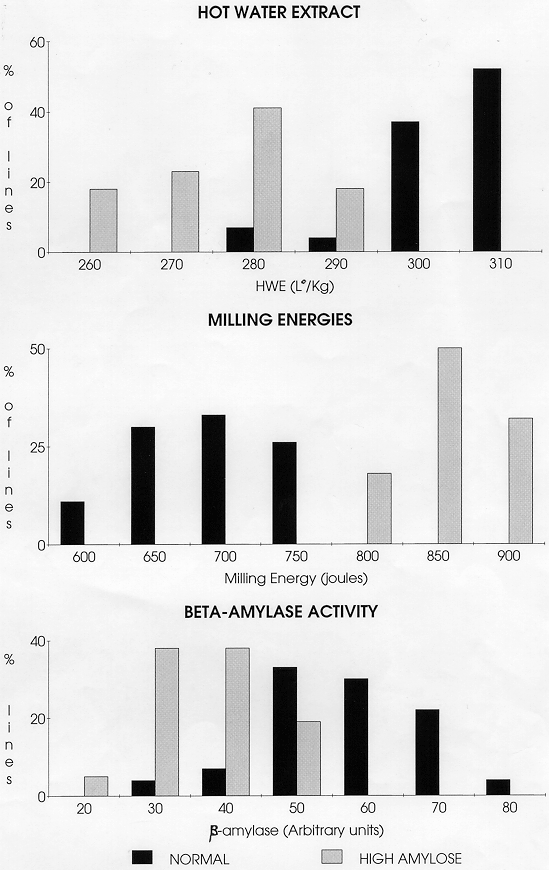
Fig.1. Results of quality tests for normal and high amylose inbred lines, presented as the proportion of lines within particular ranges.
However, deleterious quality factors, less readily explained by variation in starch composition, have also been associated with the high amylose gene, including increased levels of both grain nitrogen and milling energy and lower beta-amylase activity (Swanston & Forster, 1995). These data were obtained from random inbred lines, produced from F1 doubled haploids, giving a range of genetic backgrounds not present in the earlier backcross experiments, but with only one cycle of crossing during their development.
Production of inbred lines by single seed descent (SSD) enables several cycles of selfing, during which weak genetic linkages will be broken. However, Swanston et al. (1995a) suggested that high amylose inbred lines, produced in this way, had high levels of protein, into which the starch granules embedded firmly, reducing modification during malting. This data derived, however, from a small number of lines, in a background of poor malting quality. Swanston (1994) comparing normal and high amylose inbred lines, from a cross in which the malting cultivar Blenheim was one of the parents, suggested that deleterious effects on quality, associated with the high amylose gene, were still present in SSD lines. The data were obtained, however, in a single season, when malting characters were poorly expressed. As there is also some evidence that high amylose lines show less stability between seasons than their normal amylose parents (Swanston et al., 1995b), these experiments were continued for a further season.
In 1994, 49 SSD inbred lines (27 normal and 22 high amylose) from the cross Blenheim x BE285 (an SCRI breeding line) were grown as previously described (Swanston, 1994). Following harvest, samples retained by a 2.2 mm sieve were assessed for milling energy (Allison et al., 1979) and beta-amylase activity, following extraction with papain (Allison & Swanston, 1974). Results were given in arbitrary units, based on comparison with standard concentrations of commercially obtained enzyme. Samples were then malted and hot water extracts were determined (Swanston & Taylor, 1990).
The range of values for the quality components in the two populations are presented in Figure 1. While there is a small amount of overlap for both beta-amylase activity and hot water extract, no high amylose lines with high expressions of either character were obtained. The ranges for milling energy are quite distinct, with all lines of low milling energy having a normal amylose content.
The high amylose gene effects a number of starch characters, such as total starch content, amylose:amylopectin ratio, granule size and proportion, by weight, of A- and B-type granules (McDonald et al., 1991). It may also have pleiotropic effects on other grain components. Altenatively, changes in starch content and granule dimensions may have implications for the physical structure of the endosperm and its ease of disruption. The fact that higher milling energies are also observed in lines carrying the waxy gene (Swanston et al., 1995a) supports this hypothesis. It is also possible that amo1 is closely linked to other genes with deleterious effects on quality. The development and utilisation of molecular markers, to saturate the appropriate area of the barley genome, will, therefore, be of particular value in describing associations and allowing directed manipulation.
References:
Allison, M.J., Cowe, I.A., Borzucki, R., Bruce, F.M. & McHale, R. (1979). Milling energy of barley. J.Inst. Brew. 85, 262-262.
Allison, M.J. & Swanston, J.S. (1974). Relationships between beta-amylase populations in developing, mature and germinating grains of barley. J. Inst. Brew. 80, 285-291.
Ellis, R.P. (1976). The use of high amylose for the production of whisky malt. J. Inst. Brew. 82,280-281.
McDonald, A.M.L., Stark, J.R., Morrison, W.R. & Ellis, R.P. (1991). The composition of starch granules from developing barley genotypes. J. Cereal Sci. 13, 93-112.
Swanston, J.S. (1994). Malting performance of barleys with altered starch composition. PhD Thesis, Heriot-Watt University.
Swanston, J.S., Ellis, R.P. & Stark, J.R. (1995a). Effects on grain and malting quality of genes altering barley starch composition. J. Cereal Sci. 22, 265-273.
Swanston, J.S., Ellis, R.P. & Stark, J.R. (1995b). The malting properties, in contrasting seasons, of barleys with altered starch composition. Proc. 4th Inst. of Brew. Conf. on Malting, Brewing and Distilling, Aviemore, 1994, 233-236.
Swanston, J.S. & Forger B.P. (1995). Associations of barley grain quality characters with the wsp3 and amo1 loci. BGN 24, 84-86.
Swanston, J.S. & Taylor, K. (1990). The effects of different steeping regimes on water uptake, germination rate, milling energy and hot water extract. J. Inst. Brew. 96, 3-6.
Tester, R.F. & Morrison, W.R. (1993). Starches from waxy Hector and Hector barleys at four stages of grain development. J. Cereal Sci. 17, 11-18.

Fig.1. Results of quality tests for normal and high amylose inbred lines,
presented as the proportion of lines within particular ranges.